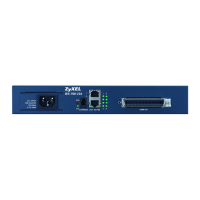Chapter 74 Queuing Method
OLT2406 User’s Guide
524
Weighted Round Robin Scheduling (WRR) uses the same algorithm as round robin scheduling, but
services queues based on their priority and queue weight (The number you configure in the queue
Weight field) rather than a fixed amount of bandwidth. WRR is activated only when a port has more
traffic than it can handle. Queues with larger weights get more service than queues with smaller
weights. This queuing mechanism is highly efficient in that it divides any available bandwidth across the
different traffic queues and returns to queues that have not yet emptied.
74.2 Port by Port Queuing Commands
The following table lists the commands for this feature.
Table 266 Port by Port Queuing Commands
COMMAND DESCRIPTION M P
queue priority <0-7> level <0-7>
Sets the IEEE 802.1p priority level-to-physical
queue mapping.
priority <0-7>: IEEE 802.1p defines up to eight
separate traffic types by inserting a tag into a
MAC-layer frame that contains bits to define
class of service. Frames without an explicit
priority tag are given the default priority of the
ingress port.
level <0-7>: The OLT has up to 8 physical
queues that you can map to the 8 priority levels.
On the OLT, traffic assigned to higher index
queues gets through faster while traffic in lower
index queues is dropped if the network is
congested.
C13
interface port-channel <aid>
Enters sub-command mode for configuring the
specified ports.
C13
spq
Sets the switch to use Strictly Priority Queuing
(SPQ) on the specified ports.
C13
wrr
Sets the switch to use Weighted Round Robin
(WRR) on the specified ports.
C13
wfq
Sets the switch to use Weighted Fair Queuing
(WFQ) on the specified ports.
C13
weight <wt1> <wt2> ... <wt8>
Assigns a weight value to each physical queue
on the OLT. When the OLT is using WRR or WFQ,
bandwidth is divided across different traffic
queues according to their weights. Queues with
larger weights get more service than queues
with smaller weights. Weight values range: 1-127.
C13

